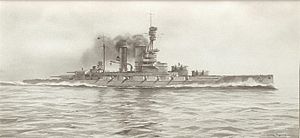SMS Götterdämmerung: Difference between revisions
No edit summary |
No edit summary |
||
| Line 11: | Line 11: | ||
* {{navy|Engleberg}} | * {{navy|Engleberg}} | ||
| Class before= [[Hohenzern Class Battleship|Hohenzern Class]] | | Class before= [[Hohenzern Class Battleship|Hohenzern Class]] | ||
| Class after= [[ | | Class after= [[Nassau Class Battleship|Tannhäuser Class]] | ||
| Subclasses= | | Subclasses= | ||
| Builder = Kaiserlichemarinewerft-Germaniawerft Großwerk | | Builder = Kaiserlichemarinewerft-Germaniawerft Großwerk | ||
Revision as of 18:16, 7 April 2019
This article is incomplete because it is pending further input from participants, or it is a work-in-progress by one author. Please comment on this article's talk page to share your input, comments and questions. Note: To contribute to this article, you may need to seek help from the author(s) of this page. |
 Rhodeve Naval identification drawing of the SMS Götterdämmerung, the image is missing the third aft gun turret.
| |
| Class overview | |
|---|---|
| Builders: | Englean Kaiserreich |
| Operators: |
|
| Preceded by: | Hohenzern Class |
| Succeeded by: | Tannhäuser Class |
| Built: | 1914-1916 |
| In commission: | 1916-1950 |
| Planned: | 2 |
| Completed: | 1 |
| Active: | 0 |
| Retired: | 1 |
| Scrapped: | 1 |
| General characteristics | |
| Type: | Battleship |
| Displacement: | 49,000 tons |
| Length: | 248 m (814 ft) |
| Beam: | 35.37 m (116.0 ft) |
| Draft: | 9.90 m (32.5 ft) |
| Propulsion: | 17 Hardelwerke boilers |
| Speed: | 19 knots (35 km/h; 22 mph) |
| Complement: | 1,313 |
| Armament: |
|
| Aircraft carried: | 1 x reconnaissance aircraft |
| Aviation facilities: | 1 x catapult |
The Götterdämmerung class was a planned set of two superbattleships to be operated by the Englean Kaiserliche-Marine during the First Great War. Planned during the early 1910s, the class was designed to succeed the previous Hohenzern class battleships and to "out-gun" the vessels currently in service with the major nations of the time. The primary feature of the vessel was the inclusion of the prototype 42 cm (16.5 in) SK L/45 guns recently developed by the Kaiserliche-Marine. Ultimately only one vessel would be built, the SMS Götterdämmerung, which would see service until 1950. The Götterdämmerung would see action in the First Great War, being a major target of the Rhodeve Navy during the Hunt for the Götterdämmerung in 1917.